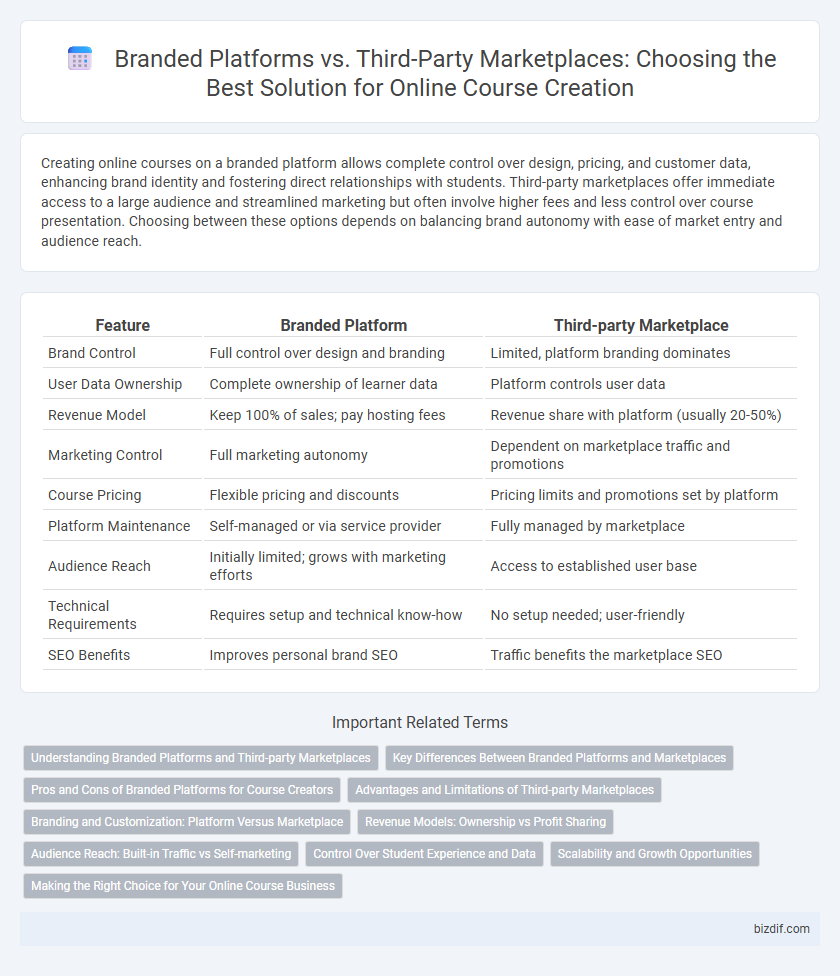Creating online courses on a branded platform allows complete control over design, pricing, and customer data, enhancing brand identity and fostering direct relationships with students. Third-party marketplaces offer immediate access to a large audience and streamlined marketing but often involve higher fees and less control over course presentation. Choosing between these options depends on balancing brand autonomy with ease of market entry and audience reach.
Table of Comparison
| Feature | Branded Platform | Third-party Marketplace |
|---|---|---|
| Brand Control | Full control over design and branding | Limited, platform branding dominates |
| User Data Ownership | Complete ownership of learner data | Platform controls user data |
| Revenue Model | Keep 100% of sales; pay hosting fees | Revenue share with platform (usually 20-50%) |
| Marketing Control | Full marketing autonomy | Dependent on marketplace traffic and promotions |
| Course Pricing | Flexible pricing and discounts | Pricing limits and promotions set by platform |
| Platform Maintenance | Self-managed or via service provider | Fully managed by marketplace |
| Audience Reach | Initially limited; grows with marketing efforts | Access to established user base |
| Technical Requirements | Requires setup and technical know-how | No setup needed; user-friendly |
| SEO Benefits | Improves personal brand SEO | Traffic benefits the marketplace SEO |
Understanding Branded Platforms and Third-party Marketplaces
Branded platforms provide course creators with full control over branding, user experience, and customer data, enabling personalized marketing strategies and direct relationships with learners. Third-party marketplaces offer built-in audiences and streamlined marketing but limit customization and often impose revenue-sharing models. Choosing between these options depends on priorities such as branding control, audience reach, and long-term business goals in online course creation.
Key Differences Between Branded Platforms and Marketplaces
Branded platforms offer course creators full control over their content, pricing, and branding, enabling a unique learner experience directly aligned with their business identity. In contrast, third-party marketplaces provide greater exposure to a broad audience but limit customization and often require revenue sharing, impacting profit margins. The choice between these options hinges on balancing control and reach for optimal online course monetization.
Pros and Cons of Branded Platforms for Course Creators
Branded platforms provide course creators with full control over their content, pricing, and user experience, enabling consistent brand identity and direct customer relationships. These platforms often require higher upfront costs and technical skills for setup and maintenance but offer greater revenue retention since there are no marketplace fees. However, attracting traffic and marketing rely entirely on the creator's efforts, which can challenge growth without an established audience.
Advantages and Limitations of Third-party Marketplaces
Third-party marketplaces offer immediate access to large, diverse audiences and built-in marketing tools, reducing the need for individual promotion efforts. However, they impose restrictions on pricing, limited customization options, and often charge substantial fees or commissions. Content creators may face competition within the platform and lack full control over user data and brand identity.
Branding and Customization: Platform Versus Marketplace
Branded platforms offer extensive branding opportunities, allowing course creators to customize logos, colors, and domain names to maintain brand consistency and enhance learner trust. In contrast, third-party marketplaces limit customization options, often featuring the marketplace's branding prominently, which can dilute the creator's brand identity. Prioritizing a branded platform supports differentiated marketing strategies and strengthens brand recognition across all learner touchpoints.
Revenue Models: Ownership vs Profit Sharing
Branded platforms offer full revenue ownership, allowing course creators to set prices and retain 100% of earnings, fostering long-term brand value and customer loyalty. Third-party marketplaces operate on profit-sharing models, typically taking 20-50% of course sales, reducing upfront marketing costs but limiting profit margins. Choosing between these models impacts financial control, scalability, and brand autonomy in the online course ecosystem.
Audience Reach: Built-in Traffic vs Self-marketing
Branded platforms offer creators full control over audience targeting but require substantial self-marketing to build traffic and engagement. Third-party marketplaces provide instant access to a large, established user base, accelerating audience reach through built-in traffic and discovery features. Choosing between these options depends on balancing immediate visibility with long-term brand building and customer ownership.
Control Over Student Experience and Data
A branded platform provides full control over the student experience and data, enabling tailored user interfaces, personalized learning paths, and direct access to analytics for improved course optimization. In contrast, third-party marketplaces limit customization options and restrict data ownership, often sharing student information with multiple vendors and hindering comprehensive insights. Choosing a branded platform fosters stronger brand consistency and enhances long-term engagement through actionable data-driven decisions.
Scalability and Growth Opportunities
A branded platform offers complete control over user experience and data, enabling scalable content delivery tailored to specific audience needs, which drives sustainable growth. Third-party marketplaces provide immediate access to a vast audience, but limit customization and data ownership, restricting long-term scalability. Investing in a branded platform fosters stronger customer relationships and diversified revenue streams essential for scaling an online course business.
Making the Right Choice for Your Online Course Business
Choosing between a branded platform and a third-party marketplace significantly impacts your online course business's control, branding, and revenue potential. Branded platforms offer full customization and stronger brand identity, while third-party marketplaces provide access to a broader audience but with higher fees and limited control. Evaluating your goals for audience reach, pricing strategy, and customer experience ensures the right platform choice aligns with your long-term business growth.
Branded Platform vs Third-party Marketplace Infographic

 bizdif.com
bizdif.com